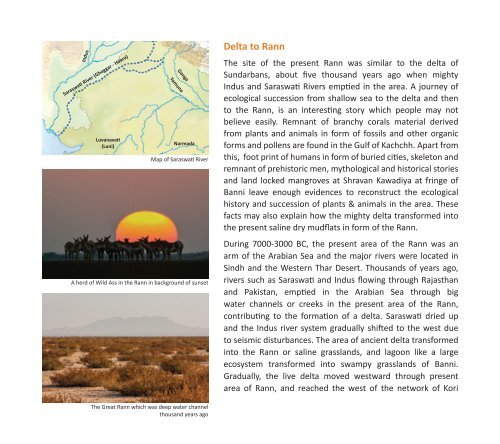Download - Gujarat Biodiversity Board - GSBB
Download - Gujarat Biodiversity Board - GSBB
Download - Gujarat Biodiversity Board - GSBB
You also want an ePaper? Increase the reach of your titles
YUMPU automatically turns print PDFs into web optimized ePapers that Google loves.
Indus<br />
Saraswati River (Ghaggar - Hakra)<br />
Luvanavati<br />
(Luni)<br />
Yamuna<br />
Ganga<br />
Narmada<br />
Map of Saraswati River<br />
A herd of Wild Ass in the Rann in background of sunset<br />
The Great Rann which was deep water channel<br />
thousand years ago<br />
Delta to Rann<br />
The site of the present Rann was similar to the delta of<br />
Sundarbans, about five thousand years ago when mighty<br />
Indus and Saraswati Rivers emptied in the area. A journey of<br />
ecological succession from shallow sea to the delta and then<br />
to the Rann, is an interesting story which people may not<br />
believe easily. Remnant of branchy corals material derived<br />
from plants and animals in form of fossils and other organic<br />
forms and pollens are found in the Gulf of Kachchh. Apart from<br />
this, foot print of humans in form of buried cities, skeleton and<br />
remnant of prehistoric men, mythological and historical stories<br />
and land locked mangroves at Shravan Kawadiya at fringe of<br />
Banni leave enough evidences to reconstruct the ecological<br />
history and succession of plants & animals in the area. These<br />
facts may also explain how the mighty delta transformed into<br />
the present saline dry mudflats in form of the Rann.<br />
During 7000-3000 BC, the present area of the Rann was an<br />
arm of the Arabian Sea and the major rivers were located in<br />
Sindh and the Western Thar Desert. Thousands of years ago,<br />
rivers such as Saraswati and Indus flowing through Rajasthan<br />
and Pakistan, emptied in the Arabian Sea through big<br />
water channels or creeks in the present area of the Rann,<br />
contributing to the formation of a delta. Saraswati dried up<br />
and the Indus river system gradually shifted to the west due<br />
to seismic disturbances. The area of ancient delta transformed<br />
into the Rann or saline grasslands, and lagoon like a large<br />
ecosystem transformed into swampy grasslands of Banni.<br />
Gradually, the live delta moved westward through present<br />
area of Rann, and reached the west of the network of Kori


